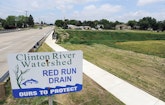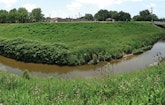Interested in Infrastructure?
Get Infrastructure articles, news and videos right in your inbox! Sign up now.
Infrastructure + Get AlertsWhen storm clouds loom over southeastern Michigan, Jim Nash pays close attention.
That’s because Nash, the Oakland County Water Resources Commissioner (OCWRC), devotes much of his professional time to improving the management of stormwater in this region directly north of Detroit. His organization is engaged in several stormwater control efforts, including the $5.1 million Red Run Inter County Drain shoal removal and bank restoration project.
Nash points out that the streams in his jurisdiction drain into Lake St. Clair and Lake Erie, and contribute to nonpoint source pollution of these Great Lakes bodies. “Lake Erie is green with algae in the summer,” he notes. “It looks like a golf course. It’s very disturbing.”
In addition to controlling runoff in Oakland County, Nash and his agency are actively promoting a collaborative regional approach to stormwater management in southeast Michigan, and are planning a regional “stormwater summit” this fall (see sidebar).
Oakland County Water Resources Commissioner
Formed early in the 20th century, and known previously as the Oakland County Drain Commissioner’s office, the OCWRC today is responsible for water supply, wastewater treatment and disposal, and drainage systems throughout a 900-square-mile area that is home to 1.3 million people. Under authority granted by Michigan state law and the Oakland County Board of Commissioners, the OCWRC operates the wastewater treatment plants for the communities of Novi, Walled Lake and Commerce, monitors lake levels, operates community drinking-
water wells, deals with soil erosion, and manages stormwater drainage systems. The Commissioner’s office employs more than 250 people and manages an annual operating budget of approximately $250 million.
Stormwater has been a troublesome issue for the county and all of southeast Michigan for decades. The four major watersheds drain to Lake St. Clair and to Lake Erie. It is estimated that runoff from impervious surfaces throughout the area exceeds a trillion gallons annually, flushing over three million pounds of phosphorus and 500 million pounds of sediment to the Great Lakes. In 2011, a particularly wet year, spring rains overwhelmed combined sewer overflow relief facilities and caused CSO backups into the basements of area residents.
Nash, who was elected to his position in 2012, is working hard to successfully complete the region’s numerous stormwater management projects and to lead the public in the search for longer-term solutions, some of which will involve behavioral changes.
“We’re working on the issues,” he says. “We need to clean this up.”
He adds: “In Michigan, we are surrounded by 20 percent of the world’s freshwater supply; we must be very careful how we use that water and what we allow to be put into it. Our economic, social and environmental future depends on the protection of our water supply and recreational waters.”
Stormwater infrastructure
One of the major infrastructure projects designed for stormwater control in Oakland County is the George W. Kuhn (GWK) underground retention treatment basin. Built in 1974 for around $30 million, and upgraded in 2000 for $147 million, it remains one of the largest combined sewer overflow facilities in the world. It is 2.2 miles long and can process up to 3 million gallons a minute.
Under normal conditions, the GWK Drainage District combined sewer flows to the Detroit metropolitan wastewater treatment plant for treatment. During wet weather, however, excess storm flow can be held in the GWK facility or treated and discharged to the Red Run stormwater channel.
Treatment consists of 16 fine screens (supplied by Headworks) and four emergency screens to remove large solids and rags, and disinfection of the overflow with storage of 150,000 gallons of sodium hypochlorite. Two auxiliary generators keep operations running in the event of a power outage, and odors are controlled by a state-of-the-art flushing system. A fiber optic network allows operators to monitor and control the system from a remote location.
While the GWK retention basin is a world-class structure, it is not the only measure Oakland County is employing to control sanitary overflows. In Farmington Hills, four communities are cooperating to build a new $46 million, 1.5-mile transport storage tunnel which will have the capacity to retain 3.7 million gallons of sanitary sewage. More sanitary sewage is being diverted to the Pontiac wastewater treatment plant, which has excess capacity as the population there has decreased in recent years. In cooperation with neighboring Macomb County, an interceptor that collapsed in 2009, creating a sinkhole, is being repaired.
Red Run improvements
Lastly, the OCWRC has recently completed improvements to the Red Run and Clinton River Drains. Red Run, which carries treated combined sewage overflows to the Clinton River, has provided stormwater relief since the early 1920s, when its riverbed was widened and deepened to enable it to carry more flow. It is a 3-mile-long open drain that has become the outlet for a number of combined sewer overflows, and is often overwhelmed by high, fast flows during storms.
The improvement project consisted of repairs to approximately 28 outfalls, and slope repairs at various locations using bio-engineering techniques. Engineering design for the project is being provided by the Army Corps of Engineers. The estimated cost of the project is over $5 million, covered by a grant from the Army Corps of Engineers.
Nash notes that rains last spring caused some slippage of the rebuilt north bank areas between Dequindre and Ryan Roads. “We are working with the Army Corps of Engineers to return to this area and make the necessary repairs.”
The Clinton River improvements are being designed to recreate a more natural course for the waterway, and make it more amenable to recreation.
“The previous channel had issues,” Nash says, noting that it was essentially a straight-line spillway. “The new channel meanders, so the flow can be slowed down.
“We’re also working with the National Oceanic and Atmospheric Administration (NOAA) to make it more of a recreational area, with pathways, trails and fishing piers.”
Nash adds that the project also involves a large amount of invasive species removal.
“It will become more of a natural area. We feel good about what’s happening there.”
Green solutions
Despite these improvements, Nash and others realize that controlling stormwater and preventing surface water pollution in southeast Michigan will take more than expensive “gray” structures. In their minds, the longer-term solutions to the problem lies with “green” approaches and cooperation from the area’s water users.
“We need to look at how we capture stormwater,” Nash says, “how we stop it from flowing [to the Great Lakes]. I’d like to see much more response from those who are responsible for creating runoff from our roofs, our parking lots and our impermeable surfaces.”
The commissioner believes a long term plan may involve charging property owners a fee for runoff, and creation of swales and other measures that allow runoff to seep back into the ground. In the future, runoff could be used for graywater, he suggests.
“The Southeast Michigan Council of Governments has performed a very good analysis of all the impermeable surfaces in our area,” Nash observes. “The study also indicated that of all the infrastructure issues we face, people felt that water and protecting water quality was most important. Some 65 to 75 percent of the respondents said they’d be willing to pay a little more to assure clean water in our region.”
Nash also thinks state regulations on phosphorus and nitrogen need to be more strongly enforced. “The state needs to get together with the agricultural community. We’re still using a lot of phosphorus [in fertilizer] even on phosphorus-rich soil. A lot of our communities have come to realize that we’re destroying our lakes with fish kills and algae blooms,” he says.
He remains hopeful about the future of stormwater control. “I get out a lot and talk with people,” he says, adding that people don’t like to see algae blooms, rivers on fire and beach closings, and when they do, they support clean water efforts.
“A regional approach is best,” he says. “Big gray infrastructure projects cost a lot of money. Low impact development is the long-term answer.”











